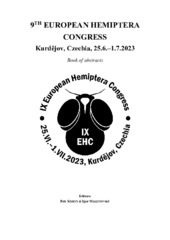| dc.description.abstract | Reptalus quinquecostatus (Dufour, 1833) is one of several species from the planthopper family Cixiidae that are known as vectors of plant pathogenic bacteria that can cause severe agroeconomic losses. Records of this species in Serbia by Horváth, Tanasijević and Janković refer to Oliarus quinquecostatus Dufour, 1883 [sic]. The species was described as inhabiting meadows and grasslands and reported as caught on Salix sp., Ulmus sp., Quercus sp., and Malva sylvestris. Modern-day molecular identification of species, i.e. sequencing of cytochrome oxidase subunit 1 (COI) gene, revealed the presence of R. quinquecostatus nymphs in the rhizosphere of Koeleria macrantha (Poaceae family) in eastern Serbia. This cixiid has been found in Serbia on various crops affected by ‘Candidatus Phytoplasma solani’: corn, grapevine, potato, and most recently, sugar beet. The occurrence on sugar beet was first reported in 2020 in northern Serbia when its population was aggregated on a boundary strip with several weeds: Convolvulus arvensis, Chenopodium album, Amaranthus retroflexus, Ambrosia artemisiifolia etc. During the 2021–2022 survey, the presence of R. quinquecostatus on sugar beet was confirmed on other localities in Serbia. Moreover, its populations were recorded on parsnip, tobacco and corn. Prunus spinosa and Crataegus sp. in microhabitats permeating arable land were also found preferable for R. quinquecostatus adults. Its several populations on different hosts were repeatedly sampled in June–July 2022. Populations on P. spinosa and Crataegus sp. were highly abundant and infected with ‘Ca. P. solani’, whereas in the agroecosystems, R. quinquecostatus is present in mixed population with R. panzeri, displaying minor precedence in the emergence of adults. Data on R. quinquecostatus plant preferences in Serbia support the polyphagy that has been previously reported throughout Europe. Since the genus Reptalus Emeljanov, 1971 has recently undergone nomenclatural and taxonomic revision, the use of the valid species name and proper morphological species identification, which in some cases should be supplemented with molecular tools, are crucial in biodiversity and insect pest research. | sr |


